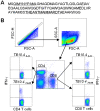Distinct differences in the expansion and phenotype of TB10.4 specific CD8 and CD4 T cells after infection with Mycobacterium tuberculosis
- PMID: 19529765
- PMCID: PMC2691482
- DOI: 10.1371/journal.pone.0005928
Distinct differences in the expansion and phenotype of TB10.4 specific CD8 and CD4 T cells after infection with Mycobacterium tuberculosis
Abstract
Background: Recently we and others have identified CD8 and CD4 T cell epitopes within the highly expressed M. tuberculosis protein TB10.4. This has enabled, for the first time, a comparative study of the dynamics and function of CD4 and CD8 T cells specific for epitopes within the same protein in various stages of TB infection.
Methods and findings: We focused on T cells directed to two epitopes in TB10.4; the MHC class I restricted epitope TB10.4 (3-11) (CD8/10.4 T cells) and the MHC class II restricted epitope TB10.4 (74-88) (CD4/10.4 T cells). CD4/10.4 and CD8/10.4 T cells displayed marked differences in terms of expansion and contraction in a mouse TB model. CD4/10.4 T cells dominated in the early phase of infection whereas CD8/10.4 T cells were expanded after week 16 and reached 5-8 fold higher numbers in the late phase of infection. In the early phase of infection both CD4/10.4 and CD8/10.4 T cells were characterized by 20-25% polyfunctional cells (IL-2(+), IFN-gamma(+), TNF-alpha(+)), but whereas the majority of CD4/10.4 T cells were maintained as polyfunctional T cells throughout infection, CD8/10.4 T cells differentiated almost exclusively into effector cells (IFN-gamma(+), TNF-alpha(+)). Both CD4/10.4 and CD8/10.4 T cells exhibited cytotoxicity in vivo in the early phase of infection, but whereas CD4/10.4 cell mediated cytotoxicity waned during the infection, CD8/10.4 T cells exhibited increasing cytotoxic potential throughout the infection.
Conclusions/significance: Our results show that CD4 and CD8 T cells directed to epitopes in the same antigen differ both in their kinetics and functional characteristics throughout an infection with M. tuberculosis. In addition, the observed strong expansion of CD8 T cells in the late stages of infection could have implications for the development of post exposure vaccines against latent TB.
Conflict of interest statement
Figures






References
-
- Lazarevic V, Nolt D, Flynn JL. Long-term control of Mycobacterium tuberculosis infection is mediated by dynamic immune responses. J Immunol. 2005;175:1107–1117. - PubMed
-
- van Pinxteren L, Cassidy JP, Smedegaard BHC, Agger EM, Andersen P. Control of latent Mycobacterium tuberculosis infection is dependent on CD8 T cells. Eur J Immunol. 2000;30:3689–3698. - PubMed
-
- Billeskov R, Vingsbo-Lundberg C, Andersen P, Dietrich J. Induction of CD8 T cells against a novel epitope in TB10.4: correlation with mycobacterial virulence and the presence of a functional region of difference-1. J Immunol. 2007;179:3973–3981. - PubMed
Publication types
MeSH terms
Substances
LinkOut - more resources
Full Text Sources
Other Literature Sources
Research Materials

